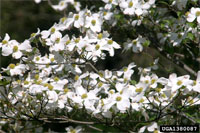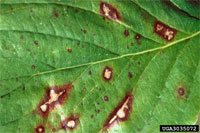by Jim McGlone, Urban Forest Conservationist, Virginia Department of Forestry
 It’s spring again and the flowers are blooming. But one important harbinger of spring is increasingly absent from our Virginia woodlands — the flowering dogwood (Cornus florida). These beautiful native trees are succumbing to the dogwood anthracnose fungus (Discula destructiva), a non-native fungus that has killed over 95 percent of the dogwoods in some areas.
It’s spring again and the flowers are blooming. But one important harbinger of spring is increasingly absent from our Virginia woodlands — the flowering dogwood (Cornus florida). These beautiful native trees are succumbing to the dogwood anthracnose fungus (Discula destructiva), a non-native fungus that has killed over 95 percent of the dogwoods in some areas.
While the loss of the dogwood’s delicate spring blooms and deep purple fall foliage is upsetting, the loss of ecological function is cause for serious concern. Dogwoods are an important food source for wildlife and a significant component of the calcium cycle in eastern forests.
Dogwood seeds, fruit, flowers, twigs, bark, and leaves are used as food by various animals. The USDA Forest Service reports that at least 36 species of birds eat the dogwood’s high fat-content berries. They are also enjoyed by mammals from chipmunks to bear. Deer and rabbits browse on the twigs, leaves and bark. In the fall, the rapidly decomposing leaves are food to many detrivores (organisms that process decomposing organic matter) from bacteria to land snails.
In addition to being a source of food for many animals, dogwoods also play a key role in the calcium cycle of the forest. Calcium is an essential nutrient for both plants and animals, and dogwood leaves are 2 to 3.5 percent calcium by weight. Dogwoods, unlike most other trees and plants, have the ability to ‘mine’ calcium from soil and rocks. The trees concentrate the mineral in their leaves and wood; when the leaves fall in autumn, that calcium becomes available to the rest of the plants and animals in the forest.
The relationship between dogwood trees, land snails and perching bird populations provides just one example of the dogwood’s invaluable role in the forest nutrient cycle, and the larger forest ecosystem. Land snails, attracted by the calcium in the leaf litter, are more prevalent under dogwood trees than under other trees in the forest. Scientists studying forest dynamics have been able to link decreases in the population of these land snails to similar decreases in perching bird populations. As dogwoods have become fewer due to anthracnose, scientists believe that perching birds have begun suffering from calcium deficiency, which is limiting their ability to produce eggshells. Thus, the loss of these beautiful trees can have wide-ranging implications for our eastern forest ecosystems.
 Dogwood anthracnose first appeared in New York and Connecticut in 1978 and has since spread up and down the east coast. Anthracnose infection appears as splotches with tan centers and purple edges on the upper leaf surface, with black spots on the underside. Infection usually proceeds from the leaves to the twigs and branches, but can start in new shoots. Infected branches have tan cankers with black spots. Diseased trees lose branches from the bottom of the tree up. Sick trees may try to compensate by producing sprouts along the trunk, which are easily infected and introduce the fungus to the trunk.
Dogwood anthracnose first appeared in New York and Connecticut in 1978 and has since spread up and down the east coast. Anthracnose infection appears as splotches with tan centers and purple edges on the upper leaf surface, with black spots on the underside. Infection usually proceeds from the leaves to the twigs and branches, but can start in new shoots. Infected branches have tan cankers with black spots. Diseased trees lose branches from the bottom of the tree up. Sick trees may try to compensate by producing sprouts along the trunk, which are easily infected and introduce the fungus to the trunk.
The best way to protect your dogwoods from anthracnose is to keep them healthy. In the wild, drought stressed trees and those growing in moist, shady woods seem especially at risk. During dry periods, water your trees at ground level with a soaker hose (wetting the leaves and branches may encourage the fungus). Give your dogwood a little sun and a 2- to 3-inch mulch bed extending at least to the drip line of the tree. Lightly fertilize as necessary with a low-nitrogen fertilizer to avoid rapid growth of susceptible shoots. Remove water sprouts from the trunk, and monitor and prune out infected leaves and branches. Finally, plant anthracnose resistant trees like the ‘Appalachian Spring’ cultivar developed from survivors of an anthracnose outbreak in Maryland.
You can also help restore calcium to the forest. Instead of throwing out your egg shells, sterilize them by toasting in the oven or zapping in the microwave. Then crush them up and mix them with the seed in your bird feeder or scatter them in your yard or garden. The snails, birds and squirrels will do the rest.
Photo top left: Chris Evans, River to River CWMA, download from www.forestryimages.org.
Photo right: R.L. Anderson, USDA Forest Service, download from www.forestryimages.org

